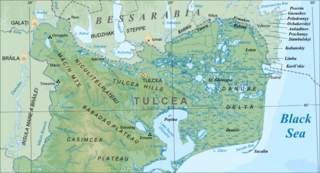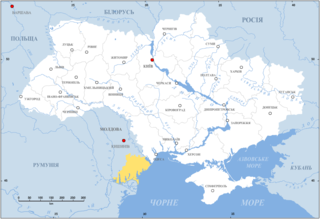
With an area of 238,397 km2 (92,046 sq mi), Romania is the twelfth-largest country in Europe. Located in Central and Southeastern Europe, bordering on the Black Sea, the country is halfway between the equator and the North Pole and equidistant from the westernmost part of Europe—the Atlantic Coast—and the most easterly—the Ural Mountains. Romania has 3,195 kilometres (1,985 mi) of border. Republic of Moldova and Ukraine lies to the east, Bulgaria lies to the south, and Serbia and Hungary to the west. In the southeast, 245 kilometres (152 mi) of sea coastline provide an important outlet to the Black Sea and the Atlantic Ocean.
Transportation infrastructure in Romania is the property of the state, and is administered by the Ministry of Transport and Infrastructure, Constructions and Tourism, except when operated as a concession, in which case the concessions are made by the Ministry of Administration and Interior.

Transport in Ukraine includes ground transportation, water, air transportation, and pipelines. The transportation sector accounts for roughly 11% of the country's gross domestic product and 7% of total employment.

The Danube Delta is the second largest river delta in Europe, after the Volga Delta, and is the best preserved on the continent. The greater part of the Danube Delta lies in Romania, with a small part in Ukraine. Its approximate surface area is 4,152 square kilometres, of which 3,446 km2 (1,331 sq mi) is in Romania. With the lagoons of Razim–Sinoe, located south of the main delta, the total area of the Danube Delta is 5,165 km2 (1,994 sq mi). The Razim–Sinoe lagoon complex is geologically and ecologically related to the delta proper; the combined territory is listed as a World Heritage Site.

The Dnieper, also called Dnipro, is one of the major transboundary rivers of Europe, rising in the Valdai Hills near Smolensk, Russia, before flowing through Belarus and Ukraine to the Black Sea. It is the longest river of Ukraine and Belarus and the fourth-longest river in Europe, after the Volga, Danube, and Ural rivers. It is approximately 2,200 km (1,400 mi) long, with a drainage basin of 504,000 square kilometres (195,000 sq mi).

Snake Island, also known as Serpent Island or Zmiinyi Island, is a Ukrainian island located in the Black Sea, near the Danube Delta, with an important role in delimiting Ukrainian territorial waters.

The Danube–Black Sea Canal is a navigable canal in Romania, which runs from Cernavodă on the Danube river, via two branches, to Constanța and Năvodari on the Black Sea. Administered from Agigea, it is an important part of the waterway link between the North Sea and the Black Sea via the Rhine–Main–Danube Canal. The main branch of the canal, with a length of 64.4 km (40.0 mi), which connects the Port of Cernavodă with the Port of Constanța, was built in 1976–1984, while the northern branch, known as the Poarta Albă–Midia Năvodari Canal, with a length of 31.2 km (19.4 mi), connecting Poarta Albă and the Port of Midia, was built between 1983 and 1987.

The Deepwater Navigation Course "Danube – Black Sea" is a deep-water canal in the Danube Delta that runs through the Danube Delta distributaries Chilia, Old Istambul and "Bystroe" or "Bystre". Through most of its length it coincides with the Romania-Ukraine border that stretches along Danube. The canal is served by the Ukrainian state company Ukrainian Sea Ports Authority and its piloting services branch Delta Lotsman. A portion of the canal, Bystroe, which stretches through the territory of Ukraine rather than along the main course raised concerns in Romania which emphasized ecological issues as it stretches through the Ukrainian Biosphere Reserve "Danube Delta".

Lenin Volga–Don Shipping Canal is a ship canal in Russia. It connects the Volga and the Don at their closest points. Opened in 1952, its length is 101 km (63 mi), 45 km (28 mi) of which is through rivers and reservoirs.

The Chiliabranch is one of three main distributary channels of the river Danube that contributes to forming the Danube Delta. Lying at the northernmost area of the delta, the distributary creates a natural border between Romania and Ukraine and is named after the two towns carrying the same name, located across from one another on both banks: Kiliya, on the northern, Ukrainian bank and Chilia Veche on the southern, Romanian bank.

Budjak, also known as Budzhak, is a historical region that was part of Bessarabia from 1812 - 1940. Situated along the Black Sea, between the Danube and Dniester rivers, this multi-ethnic region covers an area of 13,188 km2 (5,092 sq mi) and is home to approximately 600,000 people. The majority of the region is now located in Ukraine's Odesa Oblast, while the remaining part is found in the southern districts of Moldova. The region is bordered to the north by the rest of Moldova, to the west and south by Romania, and to the east by the Black Sea and the rest of Ukraine.

Vylkove is a small city located in the Ukrainian part of the Danube Delta, at utmost southwest of Ukraine, on the border with Romania. Administratively it is part of Izmail Raion (district) of Odesa Oblast (region). Vylkove hosts the administration of Vylkove urban hromada, one of the hromadas of Ukraine. Population: 7,712.

The Dnieper–Bug Canal, or the Dneprovsko-Bugsky Canal is the longest inland ship canal in Belarus. It connects the Mukhavets River and the Pina River.

Kiliia or Kilia is a town in Izmail Raion, Odesa Oblast, southwestern Ukraine. It hosts the administration of Kiliia urban hromada, one of the hromadas of Ukraine. Kiliia is located in the Danube Delta, in the historic Bessarabian district of Budjak; across the river lies the town of Chilia Veche in Romania. The Chilia branch of the Danube river, which separates Ukraine from Romania, is named after it. Population: 18,745.

The Danube is the second-longest river in Europe, after the Volga in Russia. It flows through much of Central and Southeastern Europe, from the Black Forest into the Black Sea. A large and historically important river, it was once a frontier of the Roman Empire and today connects ten European countries, running through their territories or being a border. Originating in Germany, the Danube flows southeast for 2,850 km (1,770 mi), passing through or bordering Austria, Slovakia, Hungary, Croatia, Serbia, Romania, Bulgaria, Moldova, and Ukraine. Among the many cities on the river are four national capitals: Vienna, Bratislava, Budapest, and Belgrade. Its drainage basin amounts to 817 000 km² and extends into nine more countries.
Nazi rule over the Danube River was brought about by force of arms, through annexation of Austria, invasion of Yugoslavia and of the Soviet Union and treaties with the Kingdom of Romania and Hungary, but a legal cover was provided through moves that resulted in a new international order on the river beginning in 1940 and ending in 1945.
Delta Lotsman or Delta Pilot is a branch of state company "Sea Ports Authority" and regulates vessel traffic in territorial waters of Ukraine and also providing navigation and piloting of marine vessels. The company is based in a capital of the Ukrainian shipbuilding Mykolaiv, Ukraine. It is governed by the Ukrainian Sea Ports Authority.

The Romania–Ukraine border is the state border between Romania and Ukraine. It consists of both a land and a maritime boundary. The total border length is 613.8 km (381.4 mi) including 292.2 km (181.6 mi) by rivers and 33 km (21 mi) by the Black Sea. It is part of the external border of the European Union.

Ukrainian Sea Ports Authority (USPA) (Ukrainian: Адміністрація морських портів України (АМПУ)) is a state company created in 2013 after the adoption of the law "On Sea Ports of Ukraine" and united all ports of Ukraine under one administration. Total throughput of 13 seaports in 2019 exceeded 160 million tons.
















